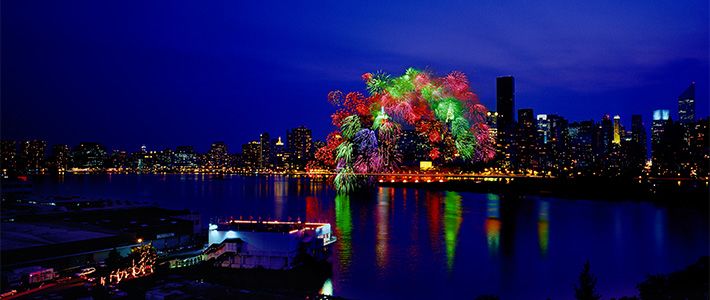
“Cool Traditions” Stay in Tune with Modern Life
Cai Guo-Qiang Makes a “Homecoming” to Japan
Society Culture- English
- 日本語
- 简体字
- 繁體字
- Français
- Español
- العربية
- Русский
A Leading Contemporary Artist
Cai Guo-Qiang has used gunpowder and fireworks to explore new frontiers in art since his youth. After launching and developing his career as an artist in Japan, he began presenting his works internationally and has held a large number of exhibitions worldwide.
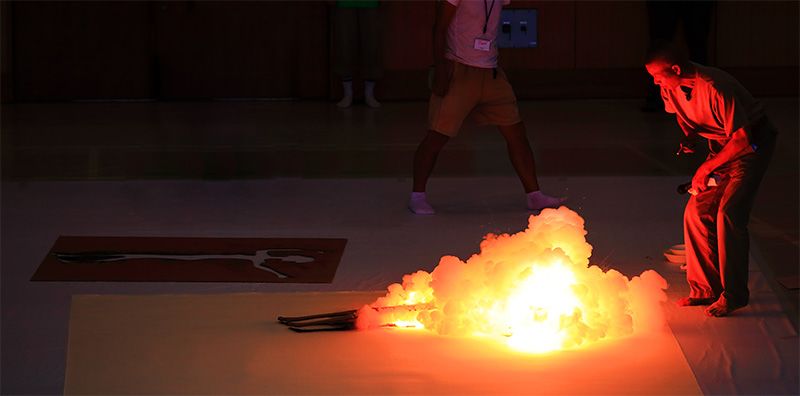 Mermaid project for the 2010 Aichi Triennale. © Cai Guo-Qiang
Mermaid project for the 2010 Aichi Triennale. © Cai Guo-Qiang
In summer 2015 Cai—who by then had become one of the world’s leading figures in contemporary art—gave a large-scale solo exhibition at the Yokohama Museum of Art. Titled Cai Guo-Qiang: here and Back Again, the exhibition—held from July 11 to October 18—presented works embodying Cai’s resolve to return to the country where he spent his formative years as an artist, get back in touch with Eastern and Japanese culture, and recall that essence in himself.
From Japan to the World
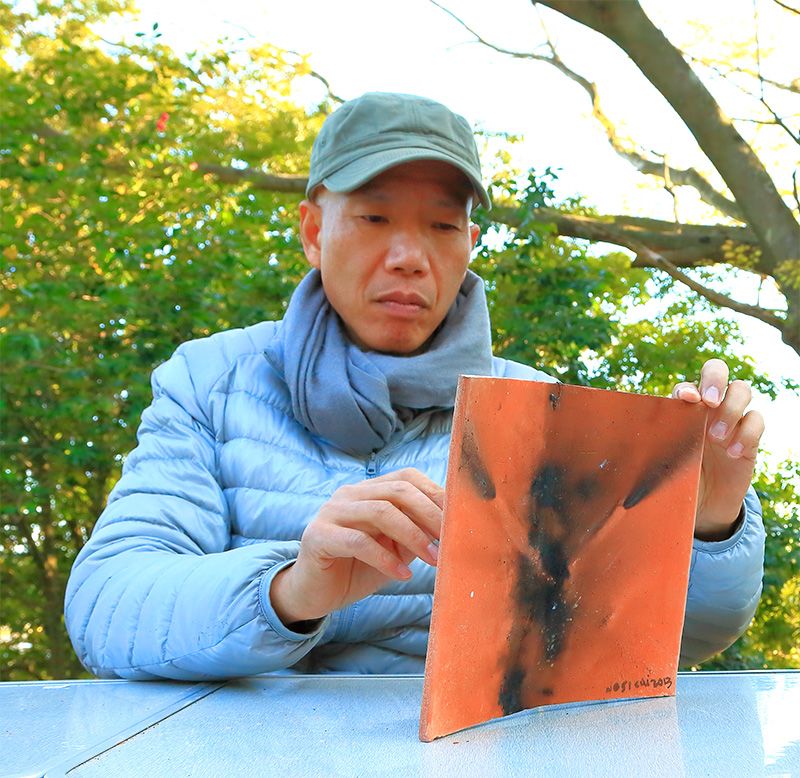 Cai signs a work created during Editions for SMoCA, one of the opening events for the Snake Museum of Contemporary Art in Iwaki, Fukushima Prefecture, in 2013. © Cai Guo-Qiang
Cai signs a work created during Editions for SMoCA, one of the opening events for the Snake Museum of Contemporary Art in Iwaki, Fukushima Prefecture, in 2013. © Cai Guo-Qiang
Born in 1957 in Quanzhou, Fujian Province, Cai Guo-Qiang came to Japan in 1986 after studying stage design at the Shanghai Theater Academy. He launched his artistic career while living in Tokyo, Toride, and Iwaki, and also studied at the University of Tsukuba. While in Japan Cai began making drawings using gunpowder on washi (Japanese paper). He conducted a series of large-scale outdoor explosive events called Project for Extraterrestrials at various venues, including as part of the 1991 Exceptional Passage: Chinese Avant-Garde Artists Exhibition in Fukuoka and other group exhibitions.
After moving to New York in 1995, Cai has continued to work in various locations, from the Americas and Europe to Australia, and has won numerous prizes, including the Golden Lion at the 1999 Venice Biennale. He was artistic director of the closing ceremonies of the 2001 APEC Conference and director of visual and special effects for the opening and closing ceremonies of the 2008 Olympic Games in Beijing—wowing television viewers around the world with spectacular fireworks displays.
Contemporary and Traditional Motifs
While constantly experimenting with new techniques, Cai also incorporates elements of traditional Chinese culture, such as feng shui philosophy and Chinese medicine, perhaps reflecting his determination not to get swept up in the latest trends in Western contemporary art. There is an unfettered feeling about his art that, combined with the artist’s easygoing demeanor, instantly draw viewers into his works.
The catalogue of the There and Back Again exhibition contains an autobiographical essay, “The 99 Stories of Cai Guo-Qiang.” In it Cai tells tales far removed from contemporary art: his memories of Quanzhou, where feng shui is still a living philosophy; the love he received from his grandparents and parents; about shaman ladies, ghosts, and hermits; and dream divination at a Taoist temple, among others. These stories offer intriguing clues to understanding Cai’s works. (The number 99 signifies an infinite cycle in Taoist thought.)
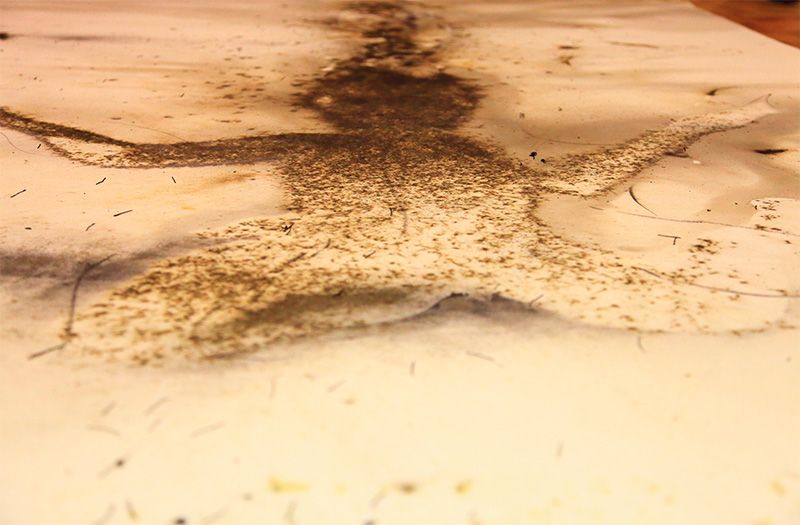 Mermaid, a drawing for the 2010 Aichi Triennale. © Cai Guo-Qiang
Mermaid, a drawing for the 2010 Aichi Triennale. © Cai Guo-Qiang
There—and Back Again
Even after moving to New York, Cai would return to Japan every two or three years for exhibitions and symposiums. He has been back every year since the Great East Japan Earthquake of 2011, opening the Snake Museum of Contemporary Art in 2013 as part of the Iwaki Manbon Sakura Project that he launched with the people of Iwaki, Fukushima Prefecture. The goal of the project, which is being conducted with Cai’s support, is to plant 99,000 cherry trees over the course of 99 years; more than 2,000 trees have already been planted.
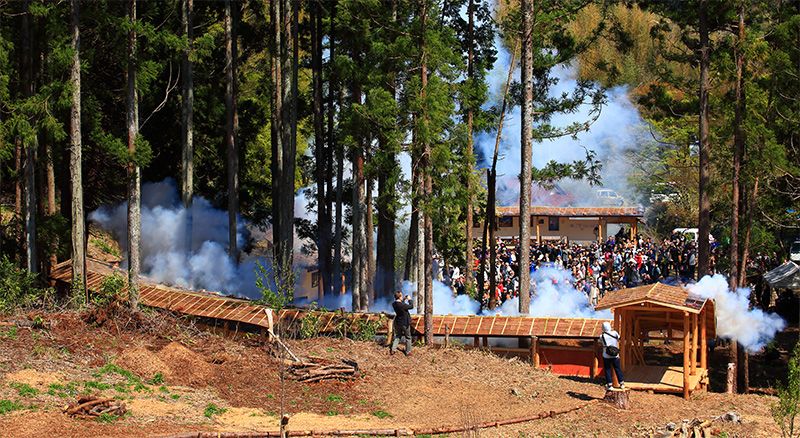 Ignition of Editions for SMoCA (Snake Museum of Contemporary Art), an opening event for the museum in Iwaki. © Cai Guo-Qiang.
Ignition of Editions for SMoCA (Snake Museum of Contemporary Art), an opening event for the museum in Iwaki. © Cai Guo-Qiang.
Just as he was contemplating increasing his activities in Japan, Cai was invited by the Yokohama Museum of Art to do a solo exhibition.
The title of the exhibition—There and Back Again—derives from “Gui qu lai ci” (The Return), a famous poem by Tao Yuanming describing nostalgia for his hometown. It signifies Cai’s return to his artistic “home” and his hope of recapturing the innocence he had as a young artist by retracing his roots. Also included in the exhibition catalogue is an essay about his thoughts on his latest return to Japan. He writes, “I focused on pictorial art, thinking about composition and emotive elements in Japanese paintings and also about Eastern culture, philosophy, and ways of life. These I sought to translate into the language and expressive techniques of contemporary visual art.”
Cai also notes that, as he researched the life and writings of Okakura Kakuzō, his interest expanded from performance art to visual art. Okakura was instrumental in establishing the Tokyo School of Fine Arts, founded the Nihon Bijutsuin (Japan Art Institute), and later headed the Asian art division of the Museum of Fine Arts, Boston. Even as the wave of Westernization swept through Meiji-era (1868–1912) Japan, Okakura was intensely aware of Eastern values and their global relevance. In the hope of conveying their essence to the Western world, he wrote The Book of Tea (1906) in English.
Daytime Fireworks
When Cai lived in Japan, he experimented extensively with fireworks made for daytime use to express color. He used colored fireworks in such recent events as Black Rainbow in Spain (2005) and Black Fireworks in Hiroshima (2008) and made great technical strides in daytime fireworks for the opening of his 2014 solo exhibition in Shanghai, Cai Guo-Qiang: The Ninth Wave.
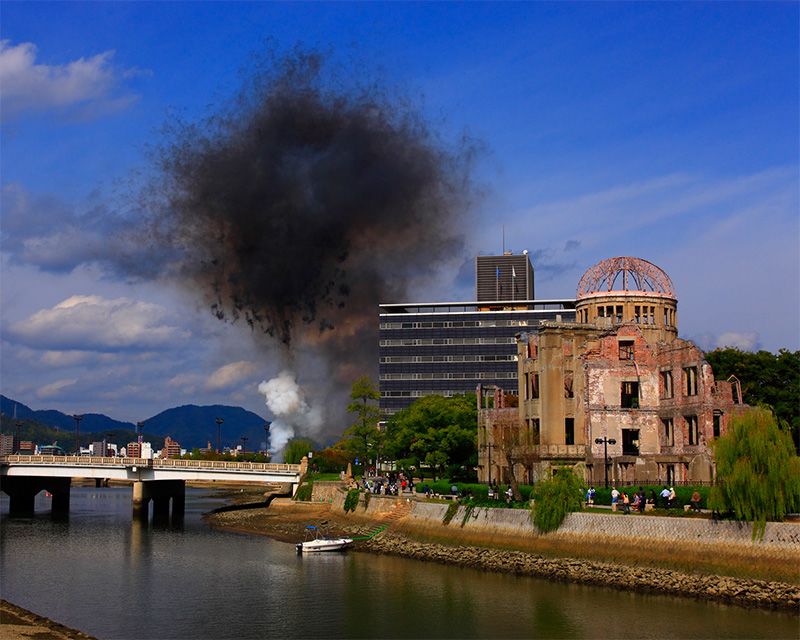 Black Fireworks, a 60-second event using black smoke shells, held on October 25, 2008, at Motomachi Riverside Park near the Atomic Bomb Dome in Hiroshima; commissioned by the Hiroshima City Museum of Contemporary Art. © Cai Guo-Qiang
Black Fireworks, a 60-second event using black smoke shells, held on October 25, 2008, at Motomachi Riverside Park near the Atomic Bomb Dome in Hiroshima; commissioned by the Hiroshima City Museum of Contemporary Art. © Cai Guo-Qiang
Whereas nighttime fireworks use light as the expressive medium and fade instantly, daytime fireworks primarily employ smoke. The smoke drifts with the air current, bleeding and melting into the canvas of the sky like an ink or watercolor painting. The sense of color and emotion that Cai developed through his work with daytime fireworks led to the Seasons of Life series, his first foray into shunga (erotic art), which he created for the Yokohama exhibition.
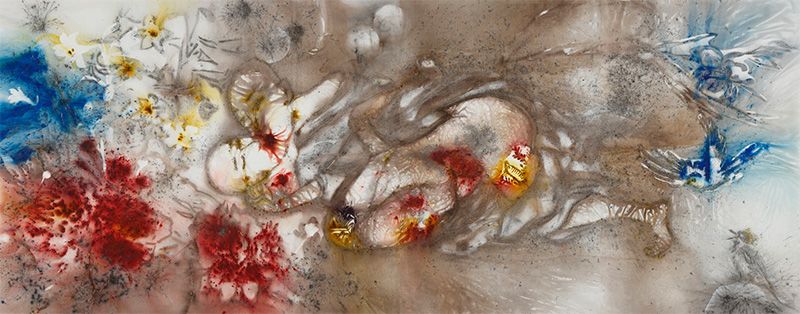 Seasons of Life: Summer, 2015. Gunpowder on canvas. 259 cm x 648 cm. From the artist’s collection. Photo courtesy of the Yokohama Museum of Art.
Seasons of Life: Summer, 2015. Gunpowder on canvas. 259 cm x 648 cm. From the artist’s collection. Photo courtesy of the Yokohama Museum of Art.
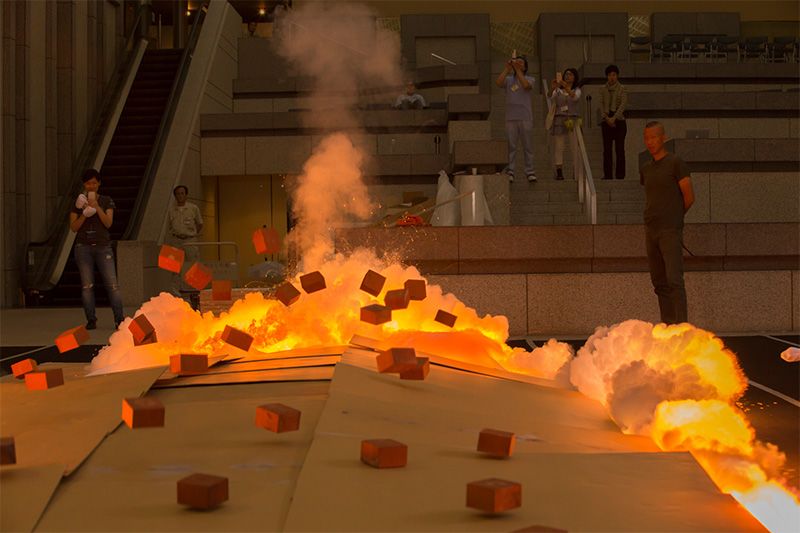 Seasons of Life: Spring, 2015. Gunpowder on canvas. 259 cm x 648 cm. From the artist’s collection; displayed at Ignition, the Yokohama Museum of Art, 2015. Photo by Kamiyama Yōsuke.
Seasons of Life: Spring, 2015. Gunpowder on canvas. 259 cm x 648 cm. From the artist’s collection; displayed at Ignition, the Yokohama Museum of Art, 2015. Photo by Kamiyama Yōsuke.
Shunga is an expression of the flow of life and incorporates seasonal changes in nature. This is true to the Eastern concept of unity of time and space, a concept that also extends to contemporary art. The medium of fireworks, which defies full human control, can lead to expressions of beauty even beyond the artist’s imagination. As Okakura wrote, the essence of Japanese culture lies in delicate attempts to discover eternal beauty in the imperfect.
A New Journey
One of the most impressive works at the Yokohama exhibition was Nighttime Sakura, an 8-meter high, 24-meter wide work that Cai produced in Japan using washi and that was displayed in the museum’s Grand Gallery. It depicts cherry blossoms spreading their tender petals, along with an owl, hidden among the blossoms, staring down at viewers with a piercing gaze.
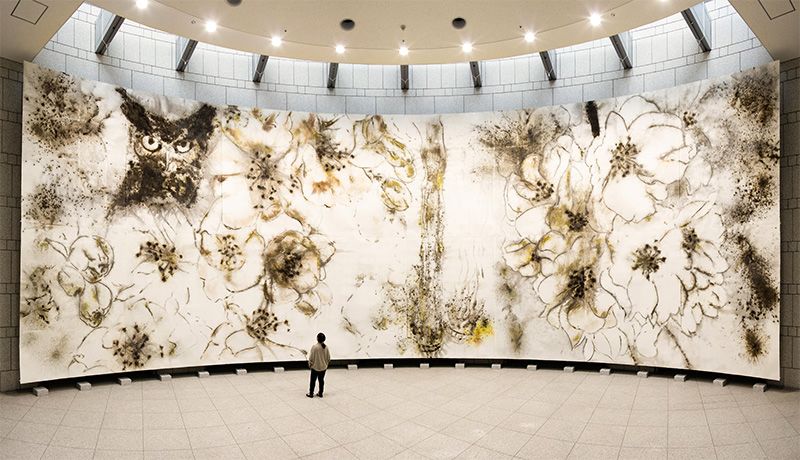 Nighttime Sakura, 2015. Gunpowder on paper. 800 cm x 2,400 cm. From the artist’s collection; viewed in installation at the Yokohama Museum of Art, 2015. Photo by Gu Kenryou. © Cai Studio
Nighttime Sakura, 2015. Gunpowder on paper. 800 cm x 2,400 cm. From the artist’s collection; viewed in installation at the Yokohama Museum of Art, 2015. Photo by Gu Kenryou. © Cai Studio
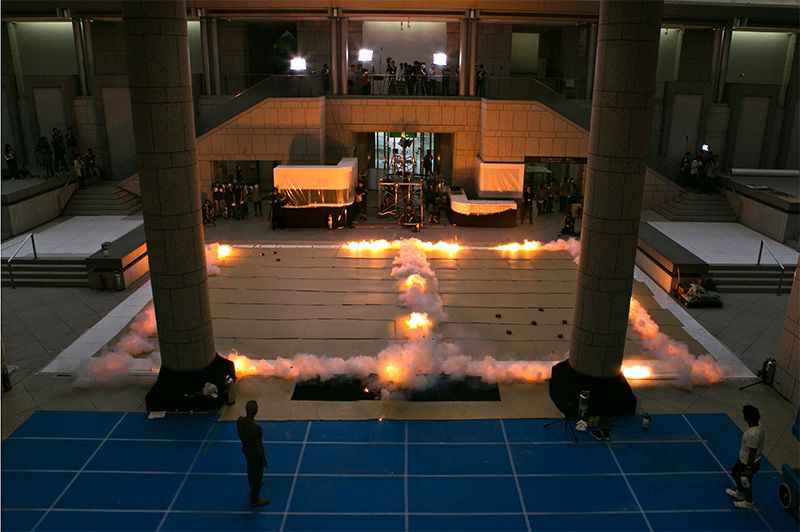 Nighttime Sakura, 2015. Gunpowder on paper. 800 cm x 2,400 cm. From the artist’s collection; displayed at Ignition, the Yokohama Museum of Art, 2015. Photo by Cai Wen-You. © Cai Studio
Nighttime Sakura, 2015. Gunpowder on paper. 800 cm x 2,400 cm. From the artist’s collection; displayed at Ignition, the Yokohama Museum of Art, 2015. Photo by Cai Wen-You. © Cai Studio
As with Seasons of Life, this work was made without the use of paintbrushes—only gunpowder ignited on paper. Asked in a television interview why he chose to depict sakura, Cai replied, “The life of cherry blossoms is fleeting; they’re gone in no time. And yet we wait all year for spring to come. There is something about the power and beauty of the blossoms that resonate with gunpowder.”
His most recent visit to Japan, Cai says, was an attempt to recapture the “East” within him as the culmination of a journey that has brought him many things. The world eagerly awaits the next leg of Cai Guo-Qiang’s remarkable artistic journey.
(Originally written in Japanese by Demura Kōichi and published on July 22, 2016. Photographs by Izumiya Gensaku, unless otherwise noted. Banner photo: Transient Rainbow, a fifteen-second event over the East River in New York, held on June 29, 2002, using 1,000 three-inch multicolor peony fireworks fitted with computer chips; commissioned by the Museum of Modern Art, New York, for the opening of MoMA Queens.)United States art China Iwaki culture sakura museum Hiroshima fireworks New York feng shui